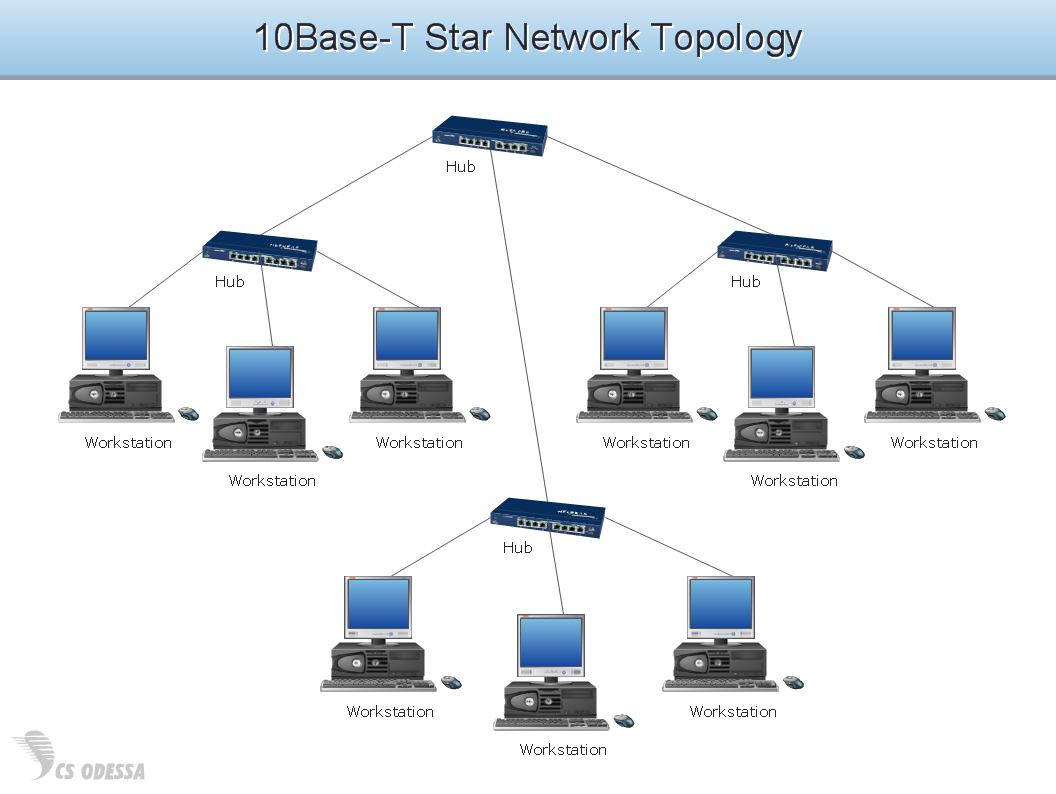"Logical topology, or signal topology, is the arrangement of devices on a computer network and how they communicate with one another. How devices are connected to the network through the actual cables that transmit data, or the physical structure of the network, is called the physical topology. Physical topology defines how the systems are physically connected. It represents the physical layout of the devices on the network. The logical topology defines how the systems communicate across the physical topologies.
Logical topologies are bound to network protocols and describe how data is moved across the network. ...
EXAMPLE : twisted pair Ethernet is a logical bus topology in a physical star topology layout. while IBM's token ring is a logical ring topology, it is physically set up in star topology." [Logical topology. Wikipedia]
This Cisco logical computer network diagram example was created using the ConceptDraw PRO diagramming and vector drawing software extended with the Cisco Network Diagrams solution from the Computer and Networks area of ConceptDraw Solution Park.
Logical topologies are bound to network protocols and describe how data is moved across the network. ...
EXAMPLE : twisted pair Ethernet is a logical bus topology in a physical star topology layout. while IBM's token ring is a logical ring topology, it is physically set up in star topology." [Logical topology. Wikipedia]
This Cisco logical computer network diagram example was created using the ConceptDraw PRO diagramming and vector drawing software extended with the Cisco Network Diagrams solution from the Computer and Networks area of ConceptDraw Solution Park.
"Star networks are one of the most common computer network topologies. In its simplest form, a star network consists of one central switch, hub or computer, which act as a conduit to transmit messages. This consists of a central node, to which all other nodes are connected; this central node provides a common connection point for all nodes through a hub. In star topology, every node (computer workstation or any other peripheral) is connected to a central node called a hub or switch. The switch is the server and the peripherals are the clients. Thus, the hub and leaf nodes, and the transmission lines between them, form a graph with the topology of a star." [Star network. Wikipedia]
The computer network diagram example "10Base-T star topology" was created using the ConceptDraw PRO diagramming and vector drawing software extended with the Computer and Networks solution from the Computer and Networks area of ConceptDraw Solution Park.
The computer network diagram example "10Base-T star topology" was created using the ConceptDraw PRO diagramming and vector drawing software extended with the Computer and Networks solution from the Computer and Networks area of ConceptDraw Solution Park.
Network Diagram Software Topology Network
Draw Network Topology and Computer Network Diagrams, Designs, Schematics, and Network Maps using ConceptDraw in no Time!
- Network Topologies | Fully Connected Network Topology Diagram ...
- Bus Network Topology | Network Topologies | Computer Network ...
- Diagrams Of All Topology
- All Topologies
- Diagram Physical Topologies | Logical network topology diagram ...
- Physical LAN and WAN diagram - Template | Network Diagram ...
- Network Topologies | Fully Connected Network Topology Diagram ...
- Complete Network Topology | Fully Connected Network Topology ...
- Fully Connected Network Topology Diagram | Network Topologies ...
- Tree Network Topology Diagram | Fully Connected Network ...
- Fully Connected Network Topology Diagram | Hotel Network ...
- Logical network topology diagram | Local area network (LAN ...
- Star Network Topology | Network Topologies | 10Base-T star ...
- Diagram Of All Topologies Of Lan
- Star Network Topology | How To use Switches in Network Diagram ...
- All Topologies Witb Diagrams
- Network Topology Graphical Examples | Network Diagram ...
- Diagrammatic Representation Of A Bus Topology Showing All
- Star Network Topology
- Bus network topology diagram


